Intel's Pentium M Desktop Part II: ASUS' Pentium M to Pentium 4 Socket Adapter
by Anand Lal Shimpi on March 24, 2005 1:31 PM EST- Posted in
- CPUs
Overclocked Performance
Thus far, the Pentium M's performance is improved in some areas, but still remains weak overall in multimedia content creation applications, workstation apps, and media encoding. The ASUS CT-479 adapter allows the Pentium M to have more memory bandwidth than it needs, so if removing that bottleneck doesn't send the Pentium M to the top of the charts, then there's only one solution to improve its performance - overclocking.
Overclocking on the ASUS P4P800-SE with the CT-479 adapter is a much more positive experience than on any of the 855GME motherboards simply because the platform is far more stable when overclocked. But remember, you can't adjust the CPU core voltage or multiplier, so your only overclocking options are through increasing the FSB.
The Pentium M 770 has a 16.0x default clock multiplier running at a 133MHz FSB; we bumped the FSB up to 160MHz and took the CPU up to 2.56GHz. The memory speed stayed at a 5:4 ratio, which put our memory bus running at DDR400 speeds. Everything else remained the same, so let's look at how performance improved.
Overclocked Workstation Performance
With the exception of a couple of SPECviewperf tests, the Pentium M running at 2.56GHz ends up being a pretty formidable contender in our workstation tests:
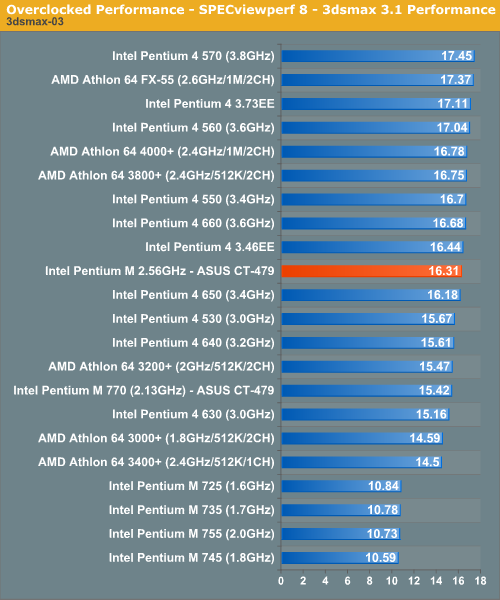
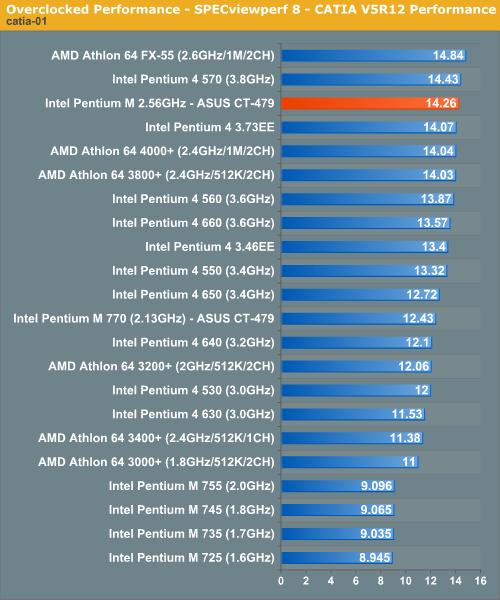
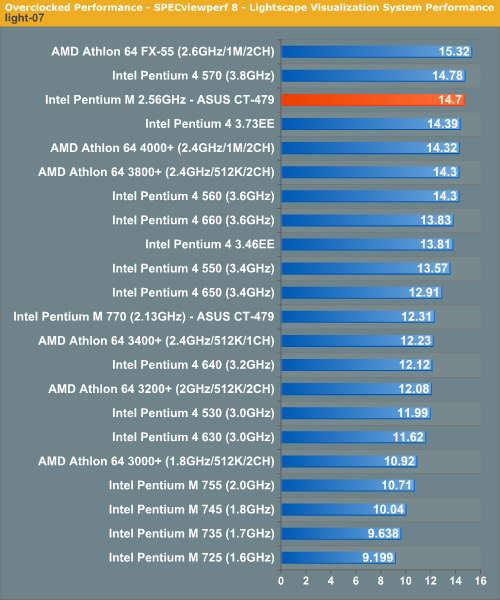
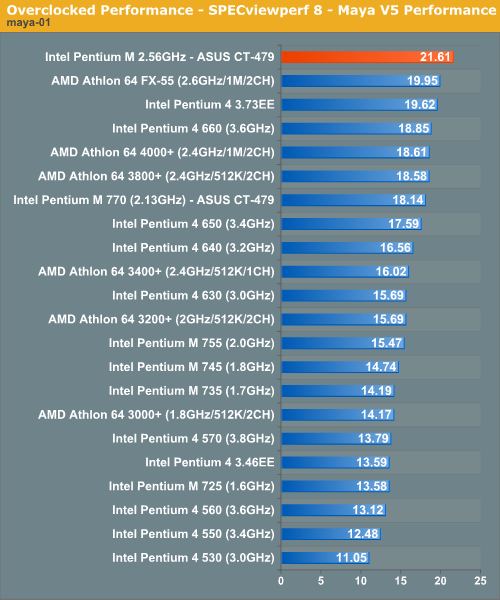
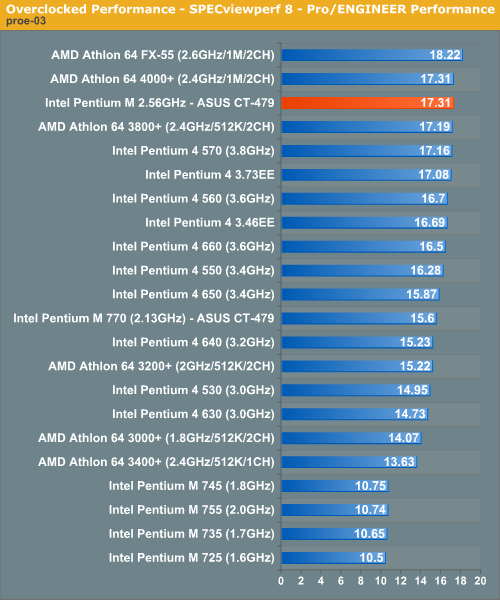
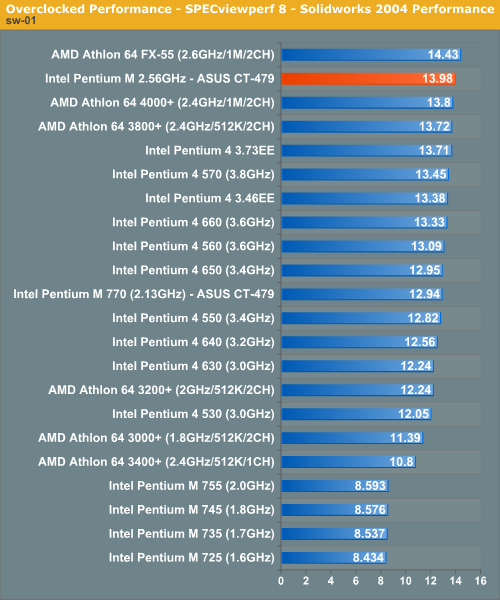
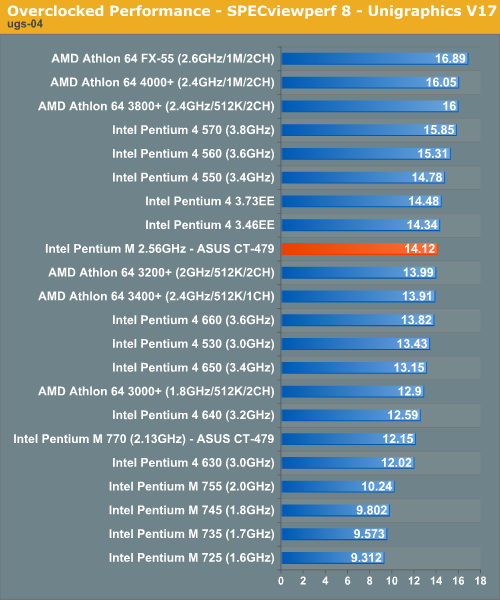
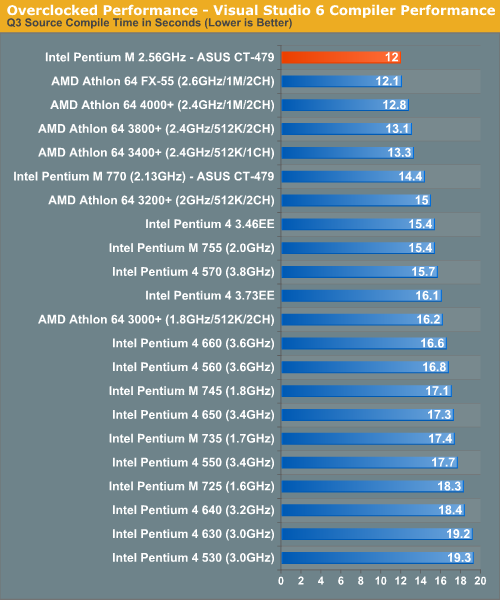










48 Comments
View All Comments
Spajky - Saturday, May 14, 2005 - link
Spajky - Saturday, May 7, 2005 - link
Some comments:http://www.anandtech.com/cpuchipsets/showdoc.aspx?...
>WinRAR 3.40
Pulling the hard disk out of the equation, we can get a much better idea of which processors are truly best suited for file compression<
>The WinRAR test is particularly memory bandwidth intensive, so the move to a platform that can feed the Pentium M adequately increases performance tremendously. However, even with the boost, the best that the Pentium M can do is match the performance of Intel desktop CPUs. It still can't touch the Athlon 64s<
Data compression, WinRAR 3.42, KB/s - Irrelevant CPU bench/graph !!!
It can be treated as a real life memory subsystem benchmark instead !
WinRAR´s built_in benchmark & hardware test" is NOT a Data Compression Bench :
some tests/benchmarks & explanation HOW IT WORKS, here:
http://freeweb.siol.net/jerman55/HP/benchMem.htm
Spajky - Saturday, May 7, 2005 - link
Some comments:http://www.anandtech.com/cpuchipsets/showdoc.aspx?...
>WinRAR 3.40
Pulling the hard disk out of the equation, we can get a much better idea of which processors are truly best suited for file compression<
>The WinRAR test is particularly memory bandwidth intensive, so the move to a platform that can feed the Pentium M adequately increases performance tremendously. However, even with the boost, the best that the Pentium M can do is match the performance of Intel desktop CPUs. It still can't touch the Athlon 64s<
Data compression, WinRAR 3.42, KB/s - Irrelevant CPU bench/graph !!!
It can be treated as a real life memory subsystem benchmark instead !
WinRAR´s built_in benchmark & hardware test" is NOT a Data Compression Bench :
some tests/benchmarks & explanation HOW IT WORKS, here:
http://freeweb.siol.net/jerman55/HP/benchMem.htm
Spajky - Saturday, May 7, 2005 - link
Some comments:http://www.anandtech.com/cpuchipsets/showdoc.aspx?...
>WinRAR 3.40
Pulling the hard disk out of the equation, we can get a much better idea of which processors are truly best suited for file compression<
>The WinRAR test is particularly memory bandwidth intensive, so the move to a platform that can feed the Pentium M adequately increases performance tremendously. However, even with the boost, the best that the Pentium M can do is match the performance of Intel desktop CPUs. It still can't touch the Athlon 64s<
Data compression, WinRAR 3.42, KB/s - Irrelevant CPU bench/graph !!!
It can be treated as a real life memory subsystem benchmark instead !
WinRAR´s built_in benchmark & hardware test" is NOT a Data Compression Bench :
some tests/benchmarks & explanation HOW IT WORKS, here:
http://freeweb.siol.net/jerman55/HP/benchMem.htm
Anemone - Sunday, April 17, 2005 - link
Curious how the XPS Gen2 would have faired in this battery of testing... the 915M seems to slightly better exploit the P-M from what I've been seeing, even though the XPS doesn't really focus on things other than gaming. However it would show what a performance focused chipset (and one that is meant to attempt to bring out the most in Dothan) is able to do under these same conditions. Yonah seems to be the magic juice though, but its sad that is really so far away from market. Intel would do well if they could bring Yonah faster to market, even if they had to keep speeds to the 2.2-2.4 range to do it.Quite an interesting article, and one I read carefully on every point.
ty
Calin - Tuesday, March 29, 2005 - link
An overclocked PM on top of the competition - even in a single benchmark? This chip is a big win for Intel, too bad that the big money come from the laptop world, where there is no competition. This is a guarantee for never decreasing prices for the Pentium M platformZebo - Monday, March 28, 2005 - link
Why's it so expensive? As far as overclocking, I don't see as it has value compared to A64, an already better rounded processor. You get a A64 3000 (which BTW has PCIe support) for $145 slam it to 2600Mhz pretty easy, 2900Mhz when Veince comes and it will destory any clock you can get out of PM. $145 super screamer :::slobber:::Meh. I'm not as excited as I once was about this chip. Everyone was saying how it's bandwidth staved in the 855 reveiws, turns out, yet again this was wishful thinking for the PM crowd desperate to see any light at end of intel tunnel. I notice no change in benchmarks with added BW.:|
fitten - Sunday, March 27, 2005 - link
#33, there's also the issue about how many data pins are exposed to the outside world. System memory DDR is 64-bits wide, as is the data bus external to the Pentium-M. Having dual channel (basically 128-bit wide memory) memory will help because the memory controller can read, in effect, two times the width each clock, but it still takes two transfers to get it across. The Athlon64 (S939 and S940) have 128-bit wide paths to memory and can transfer the entire width each transfer.valnar - Sunday, March 27, 2005 - link
I think many people, including Anand, are missing the point of the Pentium M. It was made to be a low powered, low heat processor. The fact it can even HANG with the big boys at their level is a remarkable achievement. (You can't say that about the VIA C3 processor.)Megahertz for megahertz, and watt for watt, it is easily the best processor on the market. You're comparing that against 3.8Ghz CPU's!! Of course it won't be first place. After all, it's just a 2.13Ghz. It uses 1/4 the power of the highest P4's. Compared against any other processor which comes close to those speed/power specs, it'll wipe the floor with them.
If Shuttle made their XPC's with this processor, I'd buy it in a heartbeat.
Rob
Slaimus - Sunday, March 27, 2005 - link
The real gem is the Celeron M Dothan. Need some benchmarks for that chip.